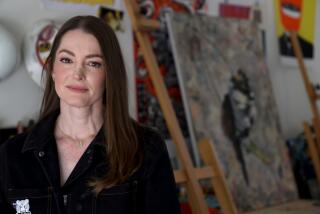Working Hollywood: Jordu Schell is one monster of an artist
When aliens are about to invade the planet, Jordu Schell is the man to call. The creature designer who conjured up a species of slimy biomechanical aliens for “Battle: Los Angeles” calls his style “convincing but also very bizarre.”
A native of Philadelphia, Schell was raised on a steady diet of creature features and Greek mythology. “One of the most memorable experiences I had as a child was seeing a revival of a film that was released in ’58 called ‘The 7th Voyage of Sinbad,’ which is a fantasy film that a stop-motion animator named Ray Harryhausen helmed the effects for with his partner in crime, Charles Schneer,” Schell said. “There’s a big Cyclops and dragons and two-headed birds, and I was just gobsmacked.”
The release of 1977’s “Star Wars: Episode IV — A New Hope” further fueled his creature obsession, followed by 1979’s “Alien,” which, to his mind, is the greatest monster movie ever made.
“That film was the first to introduce sexuality into creature design, and therefore it produced something that was much more disturbing than the monsters we’d been given up to that point,” Schell said. “And there was just something about the way the film’s put together — almost in a handheld camera documentary style — that really was groundbreaking.”
When he was in high school, he began making and selling latex monster masks for theatrical productions and costume shops. When Schell was 20, he accepted a job making masks for a company in Colorado called Distortions Unlimited before heading to Los Angeles to work on the 1990 film “Bride of Re-Animator.” This launched a career working with leading effects artists like Stan Winston and Rick Baker until he opened his own small studio in 1998.
Since then, Schell has spawned creatures for films including 2004’s “Dawn of the Dead,” 2006’s “300” and 2009’s “Avatar.” “I was definitely born to be an artist — there’s no doubt about that,” he said. “Using my imagination has been my primary interest.”
Did I request thee, maker: When it came to designing aliens for “Battle: Los Angeles,” Schell wasn’t afraid to get his hands dirty. “Having an actual three-dimensional model — or maquette — that was made in clay by hand is still the most effective way to find a character,” he said. “It’s not something that was made in some computer program and comes out very sterile with no character. It’s got a tremendous amount of human touch and believability to it.”
Size matters: “Almost always, they want to see the whole thing from head to toe,” Schell said. “I generally seem to automatically work in about one-sixth scale, which is about a foot tall. There’s something about the delicacy of that scale that I really find appealing. It’s jewel-like in its dainty size. Doing these little delicate things, you can do them relatively quickly and they look beautiful. And for conceptual maquettes, things that aren’t necessarily going to be scanned, sixth scale is just fine. When you get into stuff that needs to be scanned by a laser and fed into a computer to create a three-dimensional digital model, you probably want to work larger because you want as much detail as possible in that sculpture.”
Sticky fingers: “Battle: Los Angeles” gave Schell an opportunity to show off his slimiest skills. “Gloss polymer is essentially a polyurethane or an epoxy that, even when it’s dry, dries water-clear and has a very wet look to it to simulate moisture,” he said. “We can create translucent areas out of translucent Sculpey, a polymer clay that we can sculpt and then bake in an oven, and it becomes hard. There are a number of different ways to achieve effects, and it really depends on what the client is after.”
Nobody’s perfect: One of the tricks to making aliens look real is to include all of the scars, warts and unsightly details. “Nature is imperfect, and one of the things that is very important to me when I’m sculpting and creating stuff is to do my best to simulate the way that nature designs,” Schell said. “I see a lot of design work that seems as if it’s just flights of fancy. The designs don’t really take the laws of nature into account. Or they’re just very bland and boring. So it’s a fine line between mixing and matching nature — the reality of what exists already — and infusing it with just a little bit of fanciful bizarreness.”
More to Read
The biggest entertainment stories
Get our big stories about Hollywood, film, television, music, arts, culture and more right in your inbox as soon as they publish.
You may occasionally receive promotional content from the Los Angeles Times.










